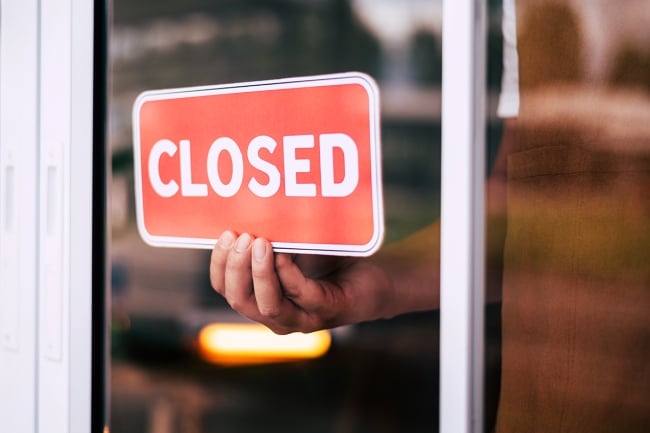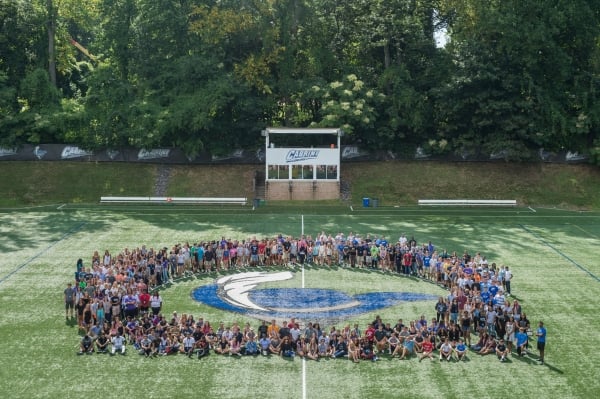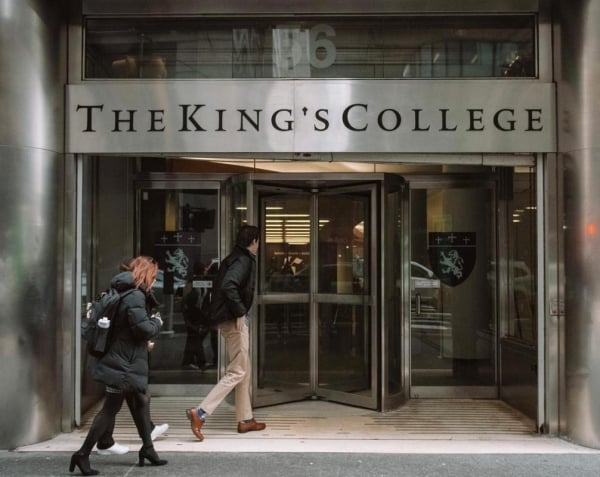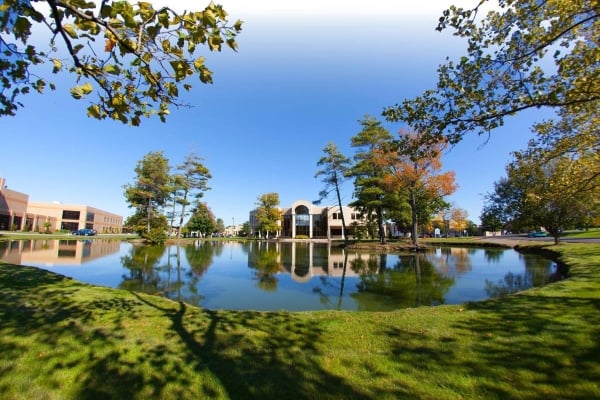You have /5 articles left.
Sign up for a free account or log in.

More than a dozen colleges announced closures this year.
Pornpimoln Puangsai/Getty Images
Nonprofit colleges and universities that announced closures this year largely fit the same profile: mostly small, private, tuition-dependent institutions with meager endowments that have seen enrollment slipping for years and have been unable to recover from those sustained losses.
Over the course of 2023, 14 nonprofit four-year colleges announced closures. (A handful of others announced mergers or acquisitions.) A 15th institution, the King’s College, did not announce it was closing but has essentially shut down, a move apparently necessitated by financial issues coupled with a loss of accreditation.
Among the 15 institutions that announced closures, 10 were religiously affiliated. Four were Catholic, which is the only denomination represented multiple times in this year’s round of closures. Three of the colleges were located in New York; Wisconsin was the only other state where more than one college announced a closure.
Presentation College
The first institution to announce a closure this year was the private Catholic institution in rural South Dakota, which in January said it would shut down after the summer 2023 term, bringing an end to the mission that began with its founding in 1951. Presentation, like many others represented here, struggled with enrollment in recent years.
The college enrolled 577 students in fall 2021, according to the recent available federal data. The college never cracked 1,000 students in any given year over the past two decades; its highest enrollment during that period appears to have been 821 students in fall 2016.
Finlandia University
Citing enrollment issues that officials attributed to demographic changes and a “steep decrease in interest in going to college,” Finlandia announced in March that it would not enroll students in fall 2023 and had entered into teach-out programs with other colleges as it prepared to close. The private Lutheran college in Michigan was founded by Finnish immigrants in 1896.
According to federal data, Finlandia enrolled 479 students in fall 2022, the last admissions cycle before it announced it would no longer accept students. That number had been in flux over the years, though enrollment has hovered around 500 students for most of the last two decades.
Iowa Wesleyan University
The private, 181-year-old United Methodist institution named inflation, enrollment challenges and decreased fundraising as the key factors driving the announcement of its closure in March. University officials also suggested that Governor Kim Reynolds’s decision to deny their request for $12 million of the state’s federal coronavirus relief funds played a part, a notion that was quickly disputed by Reynolds and local observers of higher education.
Despite what officials said, Iowa Wesleyan’s enrollment had been trending up. In fall 2022, the last regular recruiting cycle before the closure announcement, the university enrolled 820 students, up from 622 in fall 2019, the last semester before the coronavirus pandemic hit the U.S. Federal data show Iowa Wesleyan was experiencing one of its strongest enrollment years in the last two decades.
But revenue problems persisted, prompting the institution to formally cease operations in May.
Medaille University
Following the collapse of merger talks with nearby Trocaire College, Medaille announced in May that it would close due to a mix of budget issues and enrollment challenges. That closure, which faculty members told local news was driven largely by poor financial management, was almost immediate; the university officially shut down in late August.
Like many institutions that announced a closure or merger this year, Medaille had struggled to attract students. Enrollment at the private college in Buffalo, N.Y., slipped from nearly 2,400 students in fall 2013 to 1,814 in fall 2021, according to the latest federal data.
Cardinal Stritch University
President Dan Scholz cited “fiscal realities, downward enrollment trends, the [coronavirus] pandemic” and “mounting operational and facility challenges” as the factors that drove Cardinal Stritch University to announce its closure in April. The small Roman Catholic college in Wisconsin formally ended operations the next month, following its May commencement.
Plunging enrollment was key to its downfall; Cardinal Stritch lost more than 3,000 students in less than a decade, with the head count falling from 4,407 in fall 2013 to 1,365 in fall 2021, according to federal data.
Cabrini University
Despite a public appeal for partners that began in 2022, Cabrini announced in June that it would shut down, citing financial issues brought on by dwindling enrollment, the COVID-19 pandemic and other factors. Cabrini officials noted in the closure announcement that nearby Villanova University, a fellow Roman Catholic institution, was working on a deal to acquire its campus, which might allow the Cabrini name to live on in some way at Villanova.
At the time of the closure announcement, officials told Inside Higher Ed that enrollment stood at about 1,500 in fall 2022. But federal data show that number had been trending downward for years; Cabrini enrolled more than 2,400 students in fall 2013. Unable to sustain the loss of almost 1,000 students in less than a decade, the university is set to officially shut down in May 2024.

Cabrini University/Facebook
Alliance University
What was formerly known as Nyack College sold its campus in 2020 to move to New York City, rebranding as Alliance in 2022. But that wasn’t enough to fend off closure; the university announced in July that it would cease operations by Aug. 31. A loss of accreditation due to noncompliance issues prompted the sudden shutdown; the Middle States Commission on Higher Education had placed Alliance on probation over financial matters in March, and it closed without an approved teach-out plan, according to MSCHE.
The private Christian university, which traces its history back to 1882, struggled to draw students in recent years. While the latest federal data show enrollment at 1,863 in fall 2021, that number had slipped from 1,981 in fall 2019, before the COVID-19 pandemic. The drop is much more precipitous going back to fall 2013, when the university enrolled 3,082 students.
The King’s College
While the King’s College in New York has not formally declared a closure, the institution canceled its fall 2023 semester, had its accreditation stripped and is no longer operational. Its website notes that TKC is not accepting applications but does not clearly say it is closed. In its waning days, officials said in a statement, “This is not a decision to close The King’s College permanently,” adding they would continue to seek “strategic alliance opportunities.”
The small evangelical institution’s closure—whether temporary or permanent—came about after years of declining enrollment and failed efforts to expand online. TKC enrolled 384 students in fall 2021, according to recent federal data. By comparison, enrollment topped 500 for most of the past decade before falling below that number in fall 2020. Officials also noted that declining fundraising had played a role in the college’s financial issues.

Hodges University
Shortly before the start of its fall semester, the small private institution in Florida announced it was shutting down. Officials blamed declining enrollment and financial challenges when they delivered the news in late August that Hodges would call it quits before the end of August 2024.
The university enrolled just 443 students in fall 2022, according to federal data—a significant drop since the start of the pandemic; in fall 2019, 977 students were enrolled. And back in fall 2013, 2,000 students attended the university, according to federal data, meaning it lost more than 1,500 students in the past decade.
Alderson Broaddus University
West Virginia governor Jim Justice pressed state officials earlier this year to give Alderson Broaddus University more time to address its falling enrollment and shaky finances, which they feared might trigger a midsemester closure. It didn’t help. In late July, the West Virginia Higher Education Policy Commission voted to strip the university’s degree-granting authority, prompting Alderson Broaddus to formally announce its closure in August, when it also filed for bankruptcy.
The university had long dealt with accreditation and financial issues, operating at a deficit in nine of the 10 years preceding the closure announcement. Enrollment had also slipped from 1,117 students in fall 2013, according to federal data, to roughly 670 students at the time the closure was announced. ABU formally closed at the end of August, roughly a month after the HEPC vote.
Cox College
In a move that seems to straddle the line between a merger and closure, Cox College in Missouri has announced it will admit students through spring 2025 and shut down when those programs conclude. Then it will hand over certain programs to Missouri State University and Ozarks Technical Community College as part of the formation of the Alliance for Healthcare Education, a nonprofit corporation that is expected to open by fall 2025. CoxHealth, an affiliated nonprofit hospital system, will offer instructional sites to partners in the alliance.
Cox is closing despite enrollment gains; the college enrolled 956 students in fall 2021, federal data show, an increase from 880 students in fall 2013 and 486 in fall 2003.
Lincoln Christian University
Ongoing enrollment issues and a case of mistaken identity are among the issues that officials cited in October when Lincoln Christian University announced it would close by the end of the academic year. Part of the problem, officials told a local newspaper, was that prospective students were confused by the closure of the nearby but unaffiliated Lincoln College in 2022; the two private Christian institutions share the same namesake city, Lincoln, Ill.
Like its neighbor, Lincoln Christian University had been losing enrollment for years, falling from nearly 1,000 students a decade ago to 537 in fall 2021, federal data shows.
University of Wisconsin–Platteville Richland
Among the institutions on this list, the University of Wisconsin–Platteville Richland has the highest enrollment, but like most of the others, those numbers have long been trending downward. Though it enrolled 6,702 students in fall 2023—a 3 percent increase over the prior year—the university had lost more than 2,000 students since fall 2013, when the head count stood at 8,712, according to federal data.
Ultimately, hobbled by reduced state funding, Universities of Wisconsin officials pulled the plug on the branch campus.
In announcing UW Platteville’s closure, system officials also declared that two other institutions will go online: the University of Wisconsin–Milwaukee at Washington County (which state officials hoped to merge with a nearby community college) and the University of Wisconsin–Oshkosh, Fond du Lac, a move attributed to shifting enrollment trends.
Magdalen College
Magdalen College of the Liberal Arts cited low enrollment and financial challenges in November when officials announced plans to close at the end of the academic year. The small Catholic liberal arts college in New Hampshire offered only one degree: a bachelor of arts in liberal studies, with majors in literature, philosophy, history and theology. Its website emphasizes a “deep integration of liberal education and the Catholic faith within a joyful community.”
With only 60 students enrolled when it announced it was closing this fall, Magdalen College is the smallest institution represented here. While the college’s head count never surpassed more than 100 students in the last two decades, its recent high point was in fall 2016, when it enrolled 90 students, according to federal data.
The College of Saint Rose
In late October, the College of Saint Rose Board of Trustees voted to close the institution after asking local and state officials for a $5 million emergency funding lifeline that never came. The closure comes amid years of financial struggles, which prompted deep programmatic and job cuts. Officials had sought partnerships prior to the closure, but the effort was unsuccessful.
The College of Saint Rose, a private institution located in Albany, N.Y., had been shedding students for years. While federal data put Saint Rose’s head count at around 2,800 last year, enrollment collapsed from 4,004 students in fall 2019 and 4,542 students a decade ago.
Not Closing, but Changing
While various institutions announced assorted strategic partnerships that will see greater collaboration with peers, seven colleges and universities announced mergers or acquisitions that will have them absorbed by larger institutions with deeper resources.
Such arrangements were often driven by larger institutions seeking to grow enrollment through the addition of new programs and to establish footholds outside of their traditional home bases.
Valley College
The for-profit institution with four sites in Ohio and West Virginia was purchased by Hilbert College, a four-year, nonprofit Catholic college located in New York. The acquisition marks what experts believe may be the first of a for-profit college by a nonprofit religious institution—a move more commonly seen in health-care mergers and acquisitions.
Hilbert College officials told Inside Higher Ed in January that acquiring Valley College will allow them to grow online programs and tap into a pipeline of students eager to earn four-year degrees. Valley will retain its name and operational sites while sharing some services with Hilbert. The move comes several years after failed merger talks between Hilbert and St. Bonaventure University and as Hilbert seeks to expand on enrollment gains in recent years.

B. H. Carroll Theological Institute
Two Baptist institutions will become one as B. H. Carroll Theological Institute outside Dallas is absorbed by the larger East Texas Baptist University, a move announced in February. As part of ETBU, B. H. Carroll will drop the term “Institute” and use “Seminary” instead. The move is expected to be completed by early 2025, depending on necessary outside approvals.
Salus University
The Pennsylvania institution announced a merger with the much larger Drexel University over the summer. But a more accurate term might be acquisition, as Drexel—which has 23,000-plus students—absorbs Salus, a health sciences–focused institution with about 1,100 students. Drexel officials noted earlier this year that the two universities have complimentary programs. Proximity is key here: Drexel is located in Philadelphia and Salus in nearby Elkins Park.
Compass College of Film and Media
The small institution in Grand Rapids, Mich., was acquired by crosstown Calvin University in a deal announced over the summer. Both are Christian colleges, though Calvin is the much larger of the two, enrolling more than 3,300 students in fall 2023. By comparison, Compass enrolled 74 students in fall 2021, according to the latest federal data. While that number is down from the norms of recent years, Compass’s enrollment has typically hovered below 100. Its strongest year in recent history was fall 2016, when it enrolled 132 students, according to federal data.
Compass College officially ended operations as a free-standing institution over the summer.
St. Augustine College
Chicago’s St. Augustine College in April announced a merger with the larger Lewis University, which will absorb St. Augustine. Lewis, a Catholic university located outside Chicago, enrolled more than 6,000 students in fall 2021, according to recent federal data, while St. Augustine’s dwindling head count stood at 737 that same semester. St. Augustine College has lost more than half its student body since fall 2013, when enrollment topped 1,600.
The merger has already received formal approval from accreditors and state officials. Now the two colleges are awaiting federal approval before formally joining forces as one institution.
Maryland University of Integrative Health
Seeking to add new graduate-level health programs, Notre Dame University of Maryland, a private Catholic institution, announced in October that it had acquired Maryland University of Integrative Health, a private graduate school located roughly 30 miles away. Pending approvals from regulators and accreditors, the merger is expected to be finalized in late 2024 or early 2025.
Maryland University of Integrative Health’s enrollment had been trending up over the past decade, climbing from 591 students in fall 2013 to more than 800 in fall 2021, according to recent federal data. Notre Dame of Maryland, by contrast, has seen its enrollment slip, from nearly 2,900 students in fall 2013 to almost 2,200 in fall 2021, federal data show.
Multnomah University
Facing financial challenges, Multnomah University announced in October that it would become a satellite campus for Jessup University. Officials described the partnership between the two private Christian colleges—Multnomah is in Oregon and Jessup is in California—as “a necessary intervention in order to preserve the legacy of Multnomah while launching into the future.” Without the partnership, there was no viable path for Multnomah to continue, officials said.
Like most colleges on this list, Multnomah had been losing students for years. While enrollment stood in the 900s in the early 2010s, federal data show it dropped to 777 in fall 2013, 635 in fall 2019 and then 595 in fall 2021. By contrast, Jessup enrolled 1,685 students in fall 2021 and has grown in the last decade.




